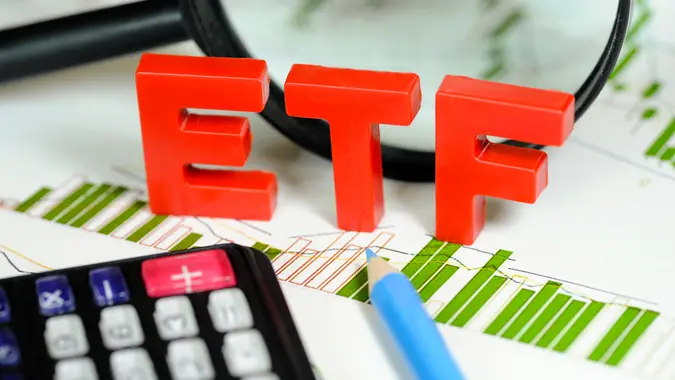6 Best Small-Cap ETFs To Invest In Right Now

Commitment to Our Readers
GOBankingRates' editorial team is committed to bringing you unbiased reviews and information. We use data-driven methodologies to evaluate financial products and services - our reviews and ratings are not influenced by advertisers. You can read more about our editorial guidelines and our products and services review methodology.

20 Years
Helping You Live Richer

Reviewed
by Experts

Trusted by
Millions of Readers
Small-cap ETFs are having a moment. These investments can be a nice way to diversify your portfolio. Historically, small-cap ETFs have done better than large-cap ETFs. Keep in mind, though, that small-cap ETFs can come with risk because you’re investing in small companies at the beginning of their growth.
As the feds look to cut interest rates, investors are looking to smaller companies for their investment needs. Maybe you should do the same. Here are the best small-cap ETFs in 2025.
6 Best Small-Cap ETFs in 2025
How do the best small-cap ETFs stack up? Take a look at this chart to determine what investment works best for you.
| ETF | Ticker | 2025 YTD Total Return | 5??’Year Annualized Return | Expense Ratio |
|---|---|---|---|---|
| Invesco S&P SmallCap 600 Revenue ETF | RWJ | -4.74% | 20.1% | 0.39% |
| Avantis U.S. Small Cap Value ETF | AVUV | -2.10% | 19.4% | 0.25% |
| Dimensional U.S. Small Cap ETF | DFAS | +0.75% | 13.3% | 0.27% |
| Principal U.S. Small??’Cap ETF | PSC | +4.19% | 15.7% | 0.38% |
| Vanguard Small Cap ETF | VB | +1.99% | 14.2% | 0.05% |
| SPDR Portfolio S&P 600 Small Cap ETF | SPSM | -2.20% | 11.5% | 0.03% |
Why Should You Invest In the Best Small-Cap ETFs?
There are several reasons to invest in small-cap ETFs. Some of those reasons include:
- Higher growth potential. Small-cap ETFs generally outperform large-cap ETFs over extended periods of time. Small companies are early in their growth potential.
- A more diversified portfolio. The opportunity to invest in small-cap ETFs adds variety to your portfolio. You’re investing in something other than big companies.
- Easy access. These ETFs allow instant access to hundreds of companies.
- Lower costs. Small-cap ETFs generally have lower expense ratios.
Small-Cap ETFs vs. Other Investment Options
How do small-cap ETFs compare to other investments? Check out this chart that compares small-cap ETFs with other investment options.
| Investment Type | Pros | Cons |
|---|---|---|
| Small-Cap ETFs | -High reward -Historically performs better than large-cap stocks -Some pay dividends |
-High risk -Can crash during recessions -Less predictable |
| Large-Cap ETFs | -Moderate growth -Medium risk -Reliable dividends |
-Lower potential growth than smaller cap -Vulnerable to broad market crashes -Less diverse |
| Bonds | -Very safe -Good hedge against stock volatility -Steady predictable outcomes |
-Low growth -Can lose value when interest rates rise -Limited protection against inflation |
| Real Estate Investment Trusts | -High dividend yields -Provides real estate exposure without owning property -Diversifies portfolio from just stocks and bonds |
-Tied heavily to real estate markets -Sensitive to high interest rates -Value can drop sharply in recessions |
| Gold or Precious Metals | -Protects during volatile economic times -Good hedge against inflation -Recognized store of value |
-Does not generate income -Long-term return is lower than stocks |
4 Risks of Investing In Small-Cap ETFs
There are inherent risks in any investment. Here are the risks of investing in small-cap ETFs:
- Higher volatility: Small-cap ETFs tend to swing more than large-cap ETFs. Economic changes and market news can cause shares to rise and fall.
- More vulnerable: Smaller-size companies tend to be more vulnerable during recessions or slow economic growth.
- Less liquidity: Small-cap ETFs are less traded than larger cap stocks or ETFs.
- Sector concentration: Small-cap ETFs tend to focus on smaller companies that focus on one sector. If the sector experiences a downturn, the small-cap ETF could be in jeopardy.
Trends Shaping Small-Cap ETFs in 2025
Various trends govern all investments. Here are some trends that are shaping the small-cap ETF market:
- Robust growth.
- Small-cap ETFs enjoyed robust growth in 2024, and this is expected to continue in 2025.
- This growth is attributed to ETF innovation as well as European ETF markets growing faster than U.S. markets in the last few years.
- Product innovation.
- Advances in technology are pushing boundaries in what an ETF can be.
- Regulatory changes in respective countries are also impacting how ETFs can expand.
- Increased growth in European ETFs.
- Investors have seen European markets as untapped markets for ETF growth.
- More educational material and resources are causing increased awareness of ETFs and, as a result, growth in the European ETF sector.
- Entry to enter the market has increased.
- Growing AUMs and new products have created increased visibility and pushed other players to enter the ETF market.
How To Buy Small-Cap ETFs in 4 Quick Steps
Wondering how to buy small-cap ETFs? Here is a step-by-step guide:
- Define your investment goals. Have a clear idea of your portfolio and whether or not you want to invest in small-cap ETFs. Decide which small-cap ETFs make sense for your long-term financial strategy.
- Choose a brokerage platform. Ideally, you want to select a brokerage platform with no commission and low fees. You should be able to navigate the platform with ease.
- Research and review data. Look for small-cap ETFs that match your goals. Check expense ratio, dividend yield and fund size.
- Decide how much to invest. Decide how much you want to invest based on what works for your financial strategy. You are now ready to place your order.
FAQ
Here are the answers to some commonly asked questions about small-cap ETFs.- What are the best small-cap ETFs for beginners?
- Here are a few small-cap ETFs to consider:
- Vanguard Small-Cap ETF (VB) offers exposure to U.S. small-cap stocks across a wide variety of sectors.
- Schwab U.S. Small-Cap ETF (SCHA) offers a low expense ratio.
- Vanguard Small-Cap Value ETF (VBR) has historically done well over extended periods of time.
- Here are a few small-cap ETFs to consider:
- Should I invest in small-cap ETFs in 2025?
- As of late April 2025, small-cap ETFs are undervalued so it could be a good opportunity to buy. With a potential interest cut, there could be a small-cap rally in the future.
- Which small-cap ETFs pay dividends?
- The following small-cap ETFs pay dividends:
- O'Shares U.S. Small-Cap Quality Dividend ETF (OUSM)
- WisdomTree U.S. SmallCap Quality Dividend Growth Fund (DGRS)
- Invesco S&P SmallCap High Dividend Low Volatility ETF (XSHD)
- The following small-cap ETFs pay dividends:
- Are small-cap ETFs good for long-term growth?
- Historically, small-cap ETFs outperform large-cap ETFs over extended periods of time. However, small-cap ETFs come with risk and volatility. You should evaluate your portfolio with a financial planner to be certain that investing in small-cap ETFs works for your goals.
Daria Uhlig and John Csiszar contributed to the reporting for this article.
Data is accurate as of July 22, 2025, and is subject to change.
Editorial Note: This content is not provided by any entity covered in this article. Any opinions, analyses, reviews, ratings or recommendations expressed in this article are those of the author alone and have not been reviewed, approved or otherwise endorsed by any entity named in this article.
Our in-house research team and on-site financial experts work together to create content that’s accurate, impartial, and up to date. We fact-check every single statistic, quote and fact using trusted primary resources to make sure the information we provide is correct. You can learn more about GOBankingRates’ processes and standards in our editorial policy.
- Financial Industry Regulatory Authority. 2022. "Market Cap Explained."
- EY. "How ETF trends are shaping market growth and innovation for 2025."
 Written by
Written by  Edited by
Edited by 
























